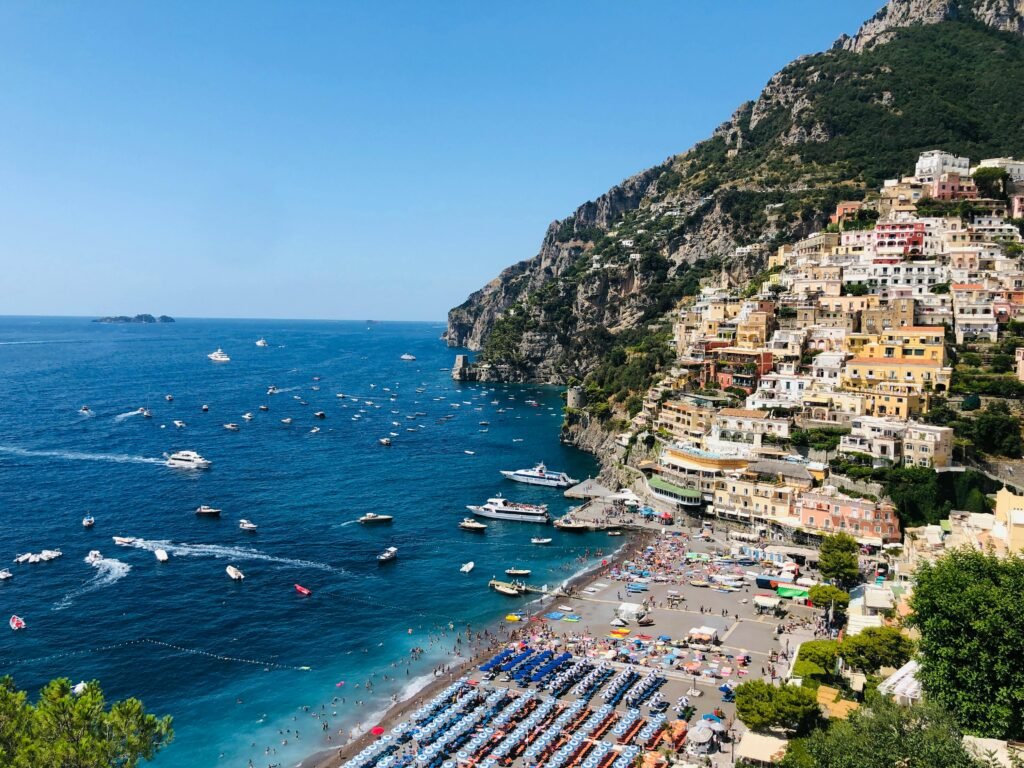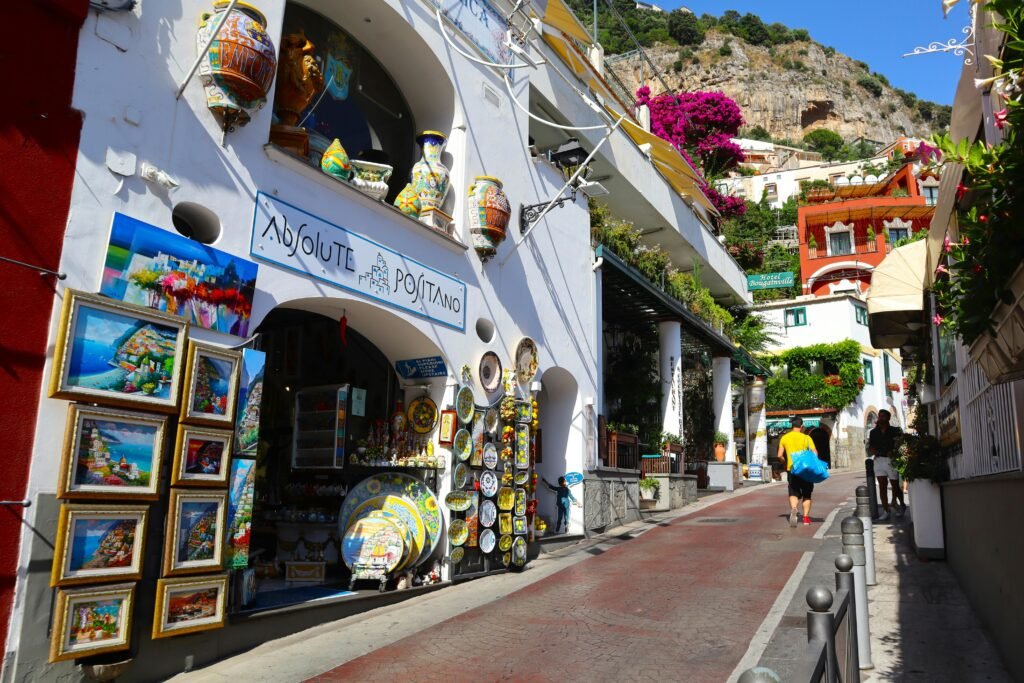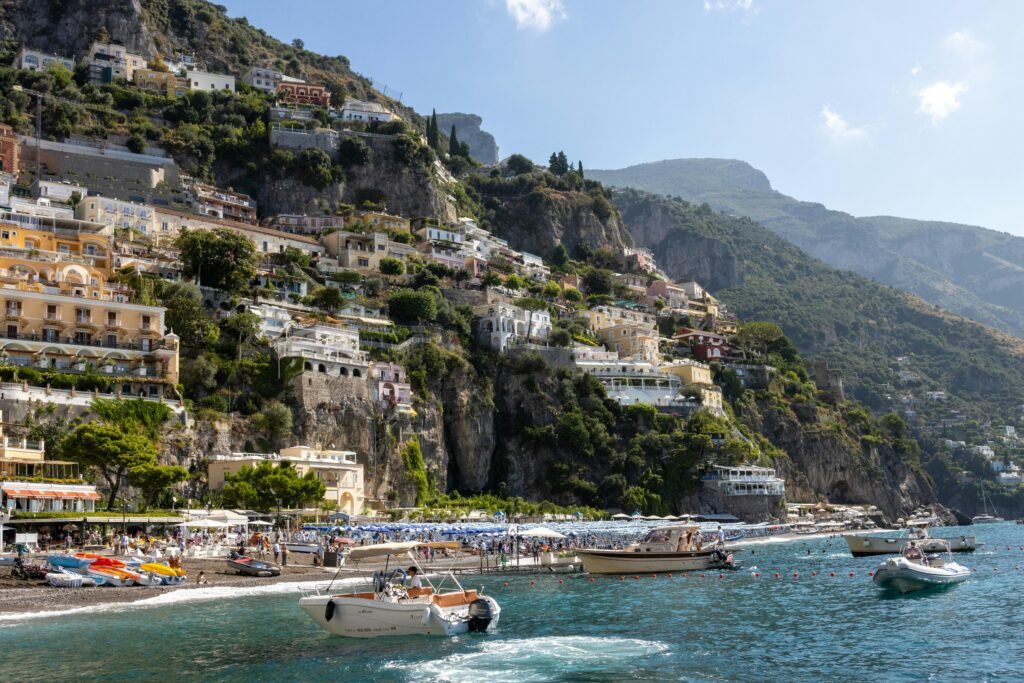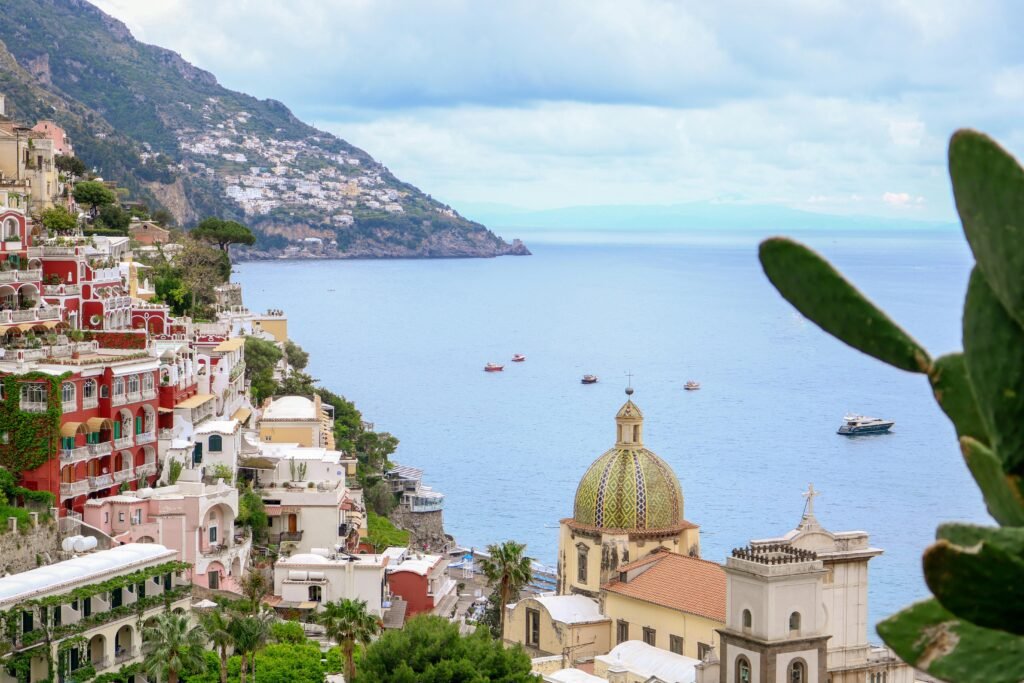It’s hard to believe, but the tiny cliffside town of Positano—just 2 square miles in size—welcomes over a million visitors every year!
That’s precisely why finding those secret local spots has become more valuable than ever.
I’ve spent countless summers chatting with locals, exploring back alleys, and discovering the pulse of authentic Positano that exists just beyond the postcard views.
I’m ready to share the hidden gems in Positano that will transform your experience from tourist to temporary local.
Secret Beaches and Swimming Spots Away from the Crowds

Spiaggia del Fornillo
While technically not a “secret,” Fornillo Beach remains criminally under visited compared to Spiaggia Grande. Just a 15-minute walk from the main beach, this quieter stretch of shoreline offers a more relaxed atmosphere with fewer crowds and better prices at the beach clubs.
I discovered Fornillo almost by accident during my second trip to Positano when I decided to follow a coastal path past the main beach.
The water here is just as crystal clear.
But the vibe is completely different! Local families tend to gather here, especially in the late afternoon when many day-trippers have already departed.
Pro tip: Head to the far end of Fornillo beach where you’ll find some smaller, rocky areas that offer natural privacy and amazing snorkeling opportunities!
Il Pupetto
Behind the main beach lies a small, hidden cove that locals call “Il Pupetto.”
Most tourists never venture this far, but if you’re willing to walk about 10 minutes past some restaurants and around a rocky outcrop, you’ll be rewarded with a quiet spot to swim.
I found this gem when I saw a group of local teenagers disappearing around the corner of the beach with their towels.
Curious, I followed them to discover this perfect little hideaway! The water here has fascinating rock formations underwater and tends to be calmer than the main beach areas.
Laurito Beach
This tiny beach is accessible only by boat or via a challenging path down from the main road.
Most tourists don’t bother with the effort, which makes it perfect for those seeking tranquility!
The first time I attempted to find Laurito, I got hopelessly lost trying to navigate the steep stairs.
I finally asked an elderly local man who pointed me in the right direction with a knowing smile.
The trek down hundreds of steps was worth it when I emerged onto a peaceful stretch of pebble beach with crystal-clear water.
For an easier option, catch the boat service that runs from Positano’s main pier – just ask for “Da Adolfo,” the famous restaurant that sits on this beach.
Arienzo Beach
Known as the “300 steps beach” (though locals will tell you it’s actually more than that!)Arienzo Beach requires some effort to reach, which naturally filters out many visitors.
The reward is a beautiful stretch of coastline that gets wonderful afternoon sun when Positano’s main beach is already in shadow.
I still remember my burning thighs after descending and then climbing back up those steps, but the quiet afternoon I spent there remains one of my favorite Positano memories.
Pack plenty of water for the return journey!
Local Kayaking Coves
Some of Positano’s most magical swimming spots are only accessible by water.
Renting a kayak from one of the smaller rental operations (avoid the main beach tourist stands) will allow you to discover tiny coves and grottoes along the coastline.
A local fisherman once pointed out several small caves to me that I would have completely missed otherwise.
These hidden spots feature emerald water that glows from within and offers a peaceful escape from the summer crowds.
Authentic Eateries Where Locals Actually Dine

La Tagliata
Perched high in the hills above Positano in the hamlet of Montepertuso is a family-run trattoria that locals consider their special occasion restaurant.
You won’t find fancy decor here – just incredible, authentic food with panoramic views that would cost triple in the center of town.
I’ll never forget my first visit to La Tagliata – I almost turned back thinking I’d gone too far up the mountain!
The restaurant follows a no-menu concept where they simply bring course after course of whatever is fresh that day.
Their homemade pasta with local rabbit ragù changed my understanding of Italian cuisine forever.
Il Ritrovo Wine Bar
Behind an unmarked door near a quiet piazza sits this local wine bar that offers the best sunset aperitivo in town.
Unlike the famous champagne bars on the main strip, this spot is frequented by local business owners unwinding after work.
I stumbled upon this place following the sound of laughter and clinking glasses down a side alley.
The owner, Marco, sources wines directly from small regional producers and pairs them with simple but delicious small plates.
The view from their tiny terrace rivals any five-star hotel, but at a fraction of the price.
Pasticceria Collina
Early risers might spot local fishermen and workers gathering at this small pastry shop before it opens to tourists.
Their sfogliatelle (shell-shaped filled pastries) are legendary among residents and disappear quickly each morning.
I forced myself out of bed at 6:30 am to try these famous pastries and found myself in a completely local crowd, with rapid-fire Italian conversations happening all around me.
The owner recognized me on my second visit and proudly showed me photos of his grandfather founding the shop decades ago.
Da Costantino
This farm-to-table restaurant requires reservations by phone only (no online booking!) and sits above Positano with spectacular views.
The family grows much of their produce and makes their own wine, creating a truly authentic experience. They have a nice garden behind the restaurant.
Finding Da Costantino required asking three different locals for directions, but the reward was a meal featuring vegetables picked that morning and pasta made by hand in the kitchen visible from my table.
The limoncello they serve at meal’s end comes from lemons grown in their garden!
Lo Guarracino
This pizza spot away from the main square charges half the price of central restaurants while maintaining incredibly high quality.
Local families fill the simple tables on weekend evenings.
I discovered this place when I asked my hotel’s housekeeper where she would go for dinner with her family.
The owner’s nonna still makes the tiramisu daily, and their wood-fired pizzas use a sourdough starter that’s been maintained for generations.
Artisan Workshops and Local Shopping Secrets

Ceramiche Casola
Hidden down a residential street is this ceramic studio offering personalized pieces created by the same family for three generations.
Unlike the touristy shops along the main drag, here you can watch artists at work and even arrange to create your own piece.
I wandered in after spotting a local woman carrying a distinctively patterned ceramic bowl.
The artisan showed me clay techniques that have remained unchanged for centuries, and I left with a custom-made piece that tells a story no mass-produced souvenir could match.
La Botteguccia da Peppe
While many sandal shops claim to be “the original,” locals know to visit the backdoor workshop of Peppe, who has quietly supplied handmade footwear to celebrities and royalty for decades.
His workshop doesn’t advertise and sits behind his modest home.
Finding this place required befriending a hotel concierge who finally revealed the location after I expressed interest in authentic craftsmanship.
Peppe measured my feet and created sandals perfectly molded to them while sharing stories about famous clients he’d never name directly (though the photos on his wall told their own tales).
Artist Studios by Appointment
Several local artists maintain small studios tucked away in residential areas that open by appointment only.
These spaces showcase artwork inspired by the Amalfi Coast’s stunning landscapes but aren’t advertised to tourists.
I discovered one such studio when I complimented a painting hanging in a small café.
The owner mentioned it was by her cousin, who invited me to visit her workspace hidden in a converted boathouse.
The pieces reflected Positano’s colors and light in ways mass-produced gallery art never could.
Thursday Morning Market
While technically not hidden, the weekly market frequented by residents operates only on Thursday mornings in the upper part of town.
Here, locals shop for fresh produce, household goods, and surprisingly high-quality clothing at reasonable prices.
I stumbled upon this market while taking a “wrong” turn up a steep staircase.
Elderly residents carefully selected tomatoes while chatting with farmers they’d known for decades.
The atmosphere was completely different from the tourist areas below – authentic, unpretentious, and decidedly local.
Famiglia Marrone Limoncello
This family-run limoncello production uses lemons grown in their personal groves. Unlike commercial operations offering tours, this modest home-based business welcomes visitors who know to knock on their blue door.
A local restaurant owner whispered this recommendation to me after I complimented their house limoncello.
The family showed me how they hand-peel each lemon to avoid the bitter pith and follow a recipe that’s remained unchanged for generations.
Their small-batch production means limited availability, but the flavor is incomparable.
Scenic Viewpoints Beyond the Instagram Spots

Chiesa Nuova Terrace
Behind the Chiesa Nuova (New Church) lies a small terrace that offers panoramic views equal to any luxury hotel but remains virtually unknown to tourists.
I discovered this spot when seeking shelter from a sudden rainfall. An elderly local man nodded toward a narrow passage beside the church, which opened onto a breathtaking vista of the entire bay.
Unlike the crowded overlooks on social media, I had this view entirely to myself.
Torre di Clavel
This ancient watchtower lookout sits above the town and requires following a local path that isn’t marked on tourist maps. The 14th-century structure offers 360-degree views of the coastline.
Finding this spot required asking a local hiking guide who initially seemed reluctant to share this information.
The path winds through private property (be respectful!) before emerging at this historical lookout point that once protected the town from pirate attacks.
Nocelle Sunset Rock
High above Positano in the hamlet of Nocelle sits a large flat rock locals visit for sunset views without the crowds.
While tourists flock to beach clubs and hotel terraces, this natural platform offers the most spectacular dusk colors.
I learned about this spot from a shopkeeper who noticed my camera and suggested I was taking “the same photos as everyone else.”
His directions led me on a bus ride up the mountain and a short walk to this peaceful overlook where I watched the sun paint Positano gold and pink.
Villa Magia Gardens
Though this property is now partially a hotel, locals know about a small public access path that leads to a historic garden with unique views of Positano’s vertical landscape.
I discovered this secret entrance when I noticed local couples disappearing through what looked like a private gate during evening passeggiata.
The garden offers intimate glimpses of Positano’s architecture cascading down the cliffside from an angle most photo collections miss.
Abandoned Villa Viewpoint
On the eastern edge of town sits a partially abandoned villa that photographers in-the-know visit for the most dramatic angle of Positano.
The property’s unique position captures the town’s verticality against the blue Mediterranean.
A local artist pointed me toward this spot after seeing my sketchbook.
Reaching it requires carefully navigating what appears to be private property, but a small portion remains accessible.
The crumbling walls frame the town in a way that feels like discovering a secret window to paradise.
Cultural and Historical Sites Off the Tourist Track

Roman Villa Ruins
Few visitors know that Positano contains the remains of a first-century Roman villa buried under the Church of Santa Maria Assunta.
While part is occasionally open to tourists, locals know about additional viewpoints of the ruins.
I learned about these additional perspectives from an archaeology student working at my hotel.
She explained how the luxurious villa was preserved by the same volcanic eruption that destroyed Pompeii, but receives a fraction of the visitors.
Chapel of Santa Margherita
This tiny hidden chapel holds significant importance to local families but isn’t featured in guidebooks.
The modest building contains beautiful frescoes and offers insight into Positano’s religious traditions.
I found this chapel when following an elderly woman carrying flowers early one morning.
She explained that local families have maintained this space for generations, and many still bring offerings during personal milestones and celebrations.
Micro-Museum Casa Vassallo
In the home of a long-established Positano family sits a small museum displaying artifacts from the town’s maritime history.
This private collection opens only by word-of-mouth recommendation.
My discovery came through a conversation with a boat captain who proudly mentioned his grandfather’s contributions to this collection.
Objects include traditional fishing equipment, vintage photographs, and items recovered from shipwrecks along the coast.
Folklore Gathering at Bar Internazionale
Not a physical site but a cultural experience – on certain evenings, elderly locals gather at this unassuming bar to share stories and occasionally break into traditional songs.
I happened upon this scene when seeking a late-night espresso away from the tourist areas. What began as casual conversation evolved into impromptu singing of songs that have been passed down through generations, giving me glimpses into Positano’s traditions that no guided tour could provide.
Via Pestana
This historical pathway connected Positano to inland villages long before modern roads existed.
Sections of the original stone path remain, holding significance to the town’s founding and development.
A local guide mentioned this path when I expressed interest in Positano’s history.
Walking these ancient stones, I gained appreciation for the challenging geography early settlers navigated centuries before tourists arrived by luxury vehicles and boats.
Insider Experiences and Activities

Dawn Fishing Excursion
Several local fishermen take out small groups before sunrise to experience traditional fishing methods.
Unlike commercial fishing tours, these authentic experiences include helping with the catch and learning techniques passed down through generations.
I arranged this experience through my hotel’s night porter, who happened to be the fisherman’s cousin.
We set out at 4:30 am into the dark Mediterranean, returning with a modest catch that we later helped prepare for the family’s lunch.
The sunrise view of Positano from the water remains one of my most treasured memories.
Hidden Connecting Paths
Locals use an intricate network of staircases and paths to navigate between neighborhoods and connect to neighboring villages – many aren’t marked on maps or are labeled as private.
An elderly woman noticed me struggling up the main road and gestured toward a narrow passageway between buildings.
“Più veloce,” she insisted (faster). This shortcut led through garden terraces and emerged exactly where I needed to be, cutting my journey by twenty minutes and offering glimpses into local home life.
Villa Romana Gardens
These private gardens open only on certain days by permission of the owners.
Featuring historic terracing techniques and spectacular views, they demonstrate how locals have cultivated this vertical landscape for centuries.
I learned about access to these gardens from a waiter who noticed my interest in local plants.
His grandfather had worked as a gardener there, and he arranged a visit during one of their limited opening times.
The carefully maintained citrus trees and herb gardens showcase agricultural traditions rarely seen by visitors.
Nonna’s Kitchen Experience
Several local grandmothers occasionally welcome small groups into their homes for authentic cooking lessons using recipes preserved through generations.
These aren’t commercial cooking schools but genuine family experiences.
This opportunity came my way after I complimented a woman’s grocery selections at the Thursday market.
Her pride in traditional cooking led to an invitation to learn her techniques for gnocchi alla sorrentina.
The afternoon spent in her modest kitchen taught me more about local food culture than any restaurant could.
Evening Church Concerts
During certain seasons, local musicians perform impromptu concerts in Positano’s smaller churches.
These events are announced only by word of mouth and feature everything from classical to traditional folk music.
I discovered these performances when I noticed local residents hurrying toward a small church one evening.
Following them led to an enchanting violin performance by a music teacher from Naples. The acoustics in the ancient stone building created a magical atmosphere that commercial venues could never replicate.
Final Thought About Hidden Gems in Positano
After discovering these hidden gems in Positano, I’ve come to understand that the true magic of this cliffside paradise isn’t found in its Instagram-famous views or celebrity-approved restaurants.
The authentic heart of Positano beats in these lesser-known corners where traditions continue unchanged despite the seasonal tourist flood.
What hidden corners of Positano have you discovered?
Share your own findings in the comments below – though perhaps keep your absolute favorite spot as your own special secret, as the locals do!
Remember that the most precious souvenirs aren’t the ones you can buy in shops, but the authentic experiences that connect you to the real Positano – the one that continues to thrive behind the picture-perfect façade.



